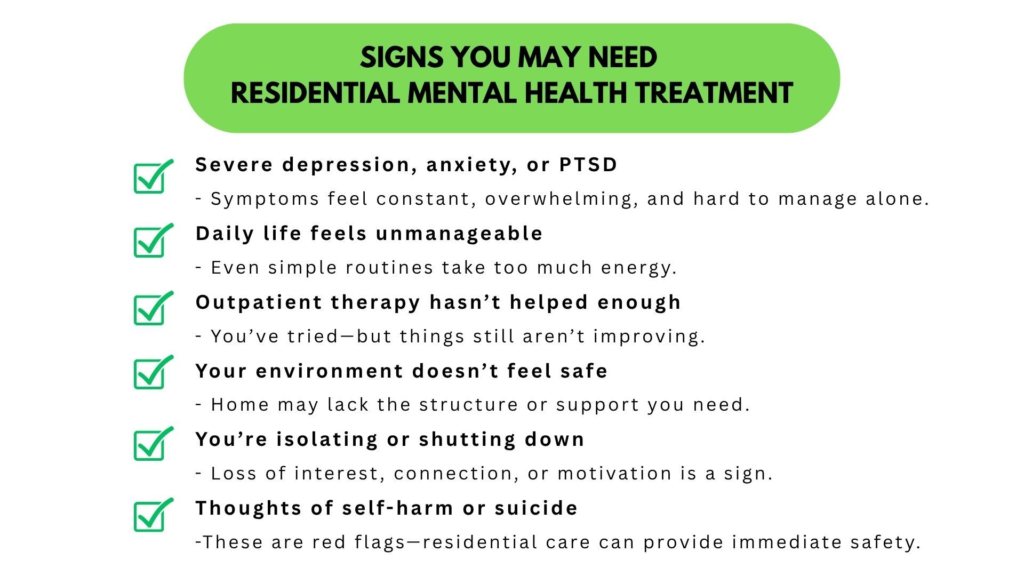When you’re living with depression, anxiety, or trauma, even getting through the day can feel like climbing uphill in the dark.
You’ve likely tried therapy. Maybe medications too. But still, something isn’t clicking—and that doesn’t mean you’ve failed. It just means you may need a deeper level of care.
Residential treatment isn’t about giving up. It’s about pressing pause—so you can find safety, structure, and real healing in a space built for recovery.
Residential mental health treatment offers 24/7 care in a safe, structured environment for people who need more than outpatient therapy.
These programs provide stability, personalized therapy, medication support, and community—helping individuals manage symptoms and rebuild their lives.
What Is Residential Mental Health Treatment?
Residential mental health treatment is a live-in program that provides round-the-clock support in a structured but home-like setting.
This level of care is designed for people experiencing significant mental health challenges—like persistent depression, severe anxiety, PTSD, or bipolar disorder—who need more than a weekly therapy session can offer. What makes it different from inpatient care?
Inpatient treatment is often short-term and hospital-based, focused on managing crises like suicidal thoughts or psychotic episodes. Residential care, on the other hand, is longer-term. More therapeutic. Less clinical. You’ll still have access to psychiatrists and nurses, but you’ll live in a calm, safe space with consistent routines and trauma-informed care woven into each part of your day.
Most residential programs include:
- Individual therapy several times a week
- Daily group therapy and psychoeducation
- Medication evaluation and ongoing management
- Structured schedules with time for rest and reflection
- Supportive community living with peers
It’s not just about reducing symptoms—it’s about helping you reclaim a sense of stability, clarity, and hope.
Is Residential Treatment the Right Fit?
Needing residential care doesn’t mean you’re broken. It means you’re strong enough to ask for what you truly need.
If any of the following sound familiar, residential treatment may be a good fit:
You’ve been dealing with severe or persistent depression, anxiety, or trauma that’s not improving You’re struggling to function—at work, at home, or even just getting out of bed Your environment isn’t safe or supportive, and you feel isolated or overwhelmed You’ve tried outpatient therapy, maybe more than once, but nothing seems to stick
You’re not alone. Many people reach a point where weekly appointments just aren’t enough. Choosing residential care is a proactive step toward regaining control—not just of your mental health, but your future.
How Long Is Residential Treatment for Mental Health?
Most residential mental health programs last between 30 and 90 days—but healing doesn’t follow a calendar.
Some people stabilize quickly. Others need more time, especially if they’re working through complex trauma or co-occurring disorders. The right length of stay depends on:
- Your diagnosis and treatment goals
- How you respond to therapy and medications
- The intensity of your symptoms and daily functioning
- Insurance coverage and logistical factors
In fact, longer stays are often more effective. A 2023 study published in Psychiatric Services found that patients who remained in residential care for more than 60 days had significantly higher rates of stabilization and were less likely to relapse.
What Happens in a Residential Mental Health Program?
Residential treatment isn’t just about managing symptoms—it’s about learning how to live again.
Each day is thoughtfully structured to support your mental, emotional, and physical well-being. There’s a rhythm to it:
- Mornings often begin with mindfulness or intention-setting
- Therapy sessions—both individual and group—make up the heart of your day
- Meal times are shared with peers, creating moments of connection and routine
- Afternoons may include skills groups, yoga, or creative therapies
- You’ll have access to psychiatrists and nurses who help manage medications and monitor your progress
- Evenings wind down with journaling, quiet time, or community check-ins
You’re not on your own. You’ll be surrounded by others who understand what it means to feel stuck, overwhelmed, or numb. And slowly, day by day, things begin to shift.
Residential programs also prioritize safety—emotionally and physically. Trauma-informed care ensures that treatment is respectful, non-judgmental, and never forceful. You’re always met where you are, not where someone thinks you should be.
What Is Residential Mental Health Treatment?
Residential treatment is a live-in program offering 24/7 support for individuals facing significant mental health challenges. It combines therapy, medication management, structure, and peer support in a safe, nurturing environment designed to promote long-term healing and emotional stability.
How Long Do People Stay In Residential Treatment?
Most residential treatment programs last between 30 and 90 days. The exact length depends on the individual’s condition, response to treatment, and insurance coverage. Longer stays often allow for deeper healing and improved outcomes in long-term mental health recovery.
What’s The Difference Between Inpatient Vs Residential Mental Health Treatment?
Inpatient care is short-term, hospital-based, and designed for crisis stabilization. Residential treatment, by contrast, provides longer-term support in a home-like setting, with a focus on recovery, emotional growth, and building skills for life beyond mental health challenges.
When Should Someone Go To Residential Treatment?
Residential care may be the right next step when mental health symptoms disrupt daily functioning, relationships, or safety—and when outpatient treatment isn’t enough. It offers a structured, supportive environment to stabilize and begin deeper emotional and psychological healing.
Will Insurance Cover A Residential Mental Health Program?
Many insurance plans cover residential treatment, either partially or in full. At Rock View Recovery, we accept most major insurance providers and assist individuals in verifying benefits, understanding coverage, and exploring financial options to access the care they need.

Quick Tip: Why Structure Matters More Than You Think
When your mental health is unsteady, unpredictability can be exhausting. That’s why residential treatment programs are designed with structure—because consistent routines restore a sense of safety and control. Every part of the day, from meals to therapy sessions, is built with purpose. This isn’t just about stability—it’s about helping you feel grounded in your own life again.
Take the Next Step Toward Healing Today
You don’t have to keep going it alone. Sometimes, the most courageous thing you can do is ask for more help—and that’s exactly what residential treatment is here to offer.
At Rock View Recovery, our residential programs are built around trauma-informed care, emotional safety, and deep healing. Whether you’re navigating depression, trauma, or just feel like you’re out of options, you’re not too far gone.
You’re not broken. You’re ready for something more—and we’re ready to walk with you.
Key Takeaways
- Residential treatment provides 24/7 care in a supportive, therapeutic environment.
- It offers a mix of individual therapy, group support, medication management, and structured routines.
- Residential programs differ from inpatient care—they’re longer-term and more home-like.
- Most people stay between 30–90 days, depending on their individual needs and progress.
- Healing takes time. Residential care gives you a consistent, safe place to recover deeply and fully.
